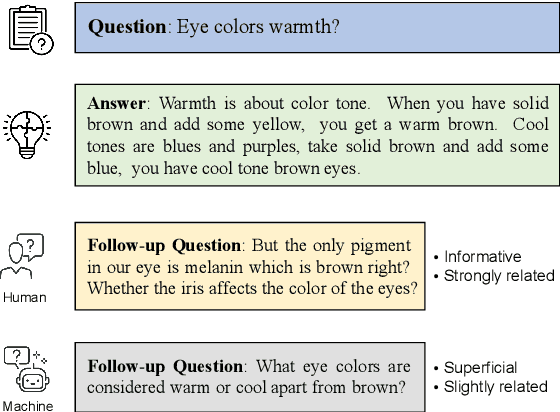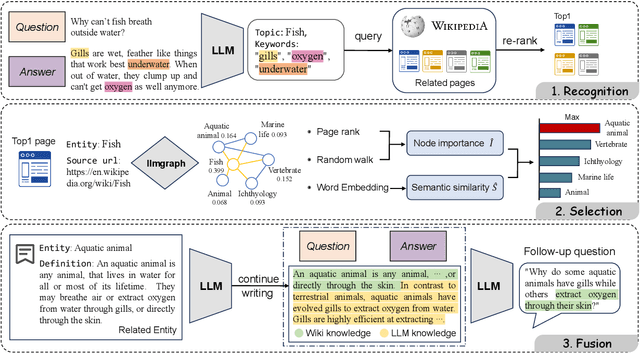Junlan Feng
China Mobile Research Institute, Beijing, China
Towards Generalized Routing: Model and Agent Orchestration for Adaptive and Efficient Inference
Sep 09, 2025Abstract:The rapid advancement of large language models (LLMs) and domain-specific AI agents has greatly expanded the ecosystem of AI-powered services. User queries, however, are highly diverse and often span multiple domains and task types, resulting in a complex and heterogeneous landscape. This diversity presents a fundamental routing challenge: how to accurately direct each query to an appropriate execution unit while optimizing both performance and efficiency. To address this, we propose MoMA (Mixture of Models and Agents), a generalized routing framework that integrates both LLM and agent-based routing. Built upon a deep understanding of model and agent capabilities, MoMA effectively handles diverse queries through precise intent recognition and adaptive routing strategies, achieving an optimal balance between efficiency and cost. Specifically, we construct a detailed training dataset to profile the capabilities of various LLMs under different routing model structures, identifying the most suitable tasks for each LLM. During inference, queries are dynamically routed to the LLM with the best cost-performance efficiency. We also introduce an efficient agent selection strategy based on a context-aware state machine and dynamic masking. Experimental results demonstrate that the MoMA router offers superior cost-efficiency and scalability compared to existing approaches.
RECALLED: An Unbounded Resource Consumption Attack on Large Vision-Language Models
Jul 24, 2025Abstract:Resource Consumption Attacks (RCAs) have emerged as a significant threat to the deployment of Large Language Models (LLMs). With the integration of vision modalities, additional attack vectors exacerbate the risk of RCAs in large vision-language models (LVLMs). However, existing red-teaming studies have largely overlooked visual inputs as a potential attack surface, resulting in insufficient mitigation strategies against RCAs in LVLMs. To address this gap, we propose RECALLED (\textbf{RE}source \textbf{C}onsumption \textbf{A}ttack on \textbf{L}arge Vision-\textbf{L}anguag\textbf{E} Mo\textbf{D}els), the first approach for exploiting visual modalities to trigger unbounded RCAs red-teaming. First, we present \textit{Vision Guided Optimization}, a fine-grained pixel-level optimization, to obtain \textit{Output Recall} adversarial perturbations, which can induce repeating output. Then, we inject the perturbations into visual inputs, triggering unbounded generations to achieve the goal of RCAs. Additionally, we introduce \textit{Multi-Objective Parallel Losses} to generate universal attack templates and resolve optimization conflicts when intending to implement parallel attacks. Empirical results demonstrate that RECALLED increases service response latency by over 26 $\uparrow$, resulting in an additional 20\% increase in GPU utilization and memory consumption. Our study exposes security vulnerabilities in LVLMs and establishes a red-teaming framework that can facilitate future defense development against RCAs.
ReDDiT: Rehashing Noise for Discrete Visual Generation
May 26, 2025Abstract:Discrete diffusion models are gaining traction in the visual generative area for their efficiency and compatibility. However, the pioneered attempts still fall behind the continuous counterparts, which we attribute to the noise (absorbing state) design and sampling heuristics. In this study, we propose the rehashing noise framework for discrete diffusion transformer, termed ReDDiT, to extend absorbing states and improve expressive capacity of discrete diffusion models. ReDDiT enriches the potential paths that latent variables can traverse during training with randomized multi-index corruption. The derived rehash sampler, which reverses the randomized absorbing paths, guarantees the diversity and low discrepancy of the generation process. These reformulations lead to more consistent and competitive generation quality, mitigating the need for heavily tuned randomness. Experiments show that ReDDiT significantly outperforms the baseline (reducing gFID from 6.18 to 1.61) and is on par with the continuous counterparts with higher efficiency.
Understanding LLMs' Cross-Lingual Context Retrieval: How Good It Is And Where It Comes From
Apr 15, 2025Abstract:The ability of cross-lingual context retrieval is a fundamental aspect of cross-lingual alignment of large language models (LLMs), where the model extracts context information in one language based on requests in another language. Despite its importance in real-life applications, this ability has not been adequately investigated for state-of-the-art models. In this paper, we evaluate the cross-lingual context retrieval ability of over 40 LLMs across 12 languages to understand the source of this ability, using cross-lingual machine reading comprehension (xMRC) as a representative scenario. Our results show that several small, post-trained open LLMs show strong cross-lingual context retrieval ability, comparable to closed-source LLMs such as GPT-4o, and their estimated oracle performances greatly improve after post-training. Our interpretability analysis shows that the cross-lingual context retrieval process can be divided into two main phases: question encoding and answer retrieval, which are formed in pre-training and post-training, respectively. The phasing stability correlates with xMRC performance, and the xMRC bottleneck lies at the last model layers in the second phase, where the effect of post-training can be evidently observed. Our results also indicate that larger-scale pretraining cannot improve the xMRC performance. Instead, larger LLMs need further multilingual post-training to fully unlock their cross-lingual context retrieval potential. Our code and is available at https://github.com/NJUNLP/Cross-Lingual-Context-Retrieval
From Superficial to Deep: Integrating External Knowledge for Follow-up Question Generation Using Knowledge Graph and LLM
Apr 08, 2025



Abstract:In a conversational system, dynamically generating follow-up questions based on context can help users explore information and provide a better user experience. Humans are usually able to ask questions that involve some general life knowledge and demonstrate higher order cognitive skills. However, the questions generated by existing methods are often limited to shallow contextual questions that are uninspiring and have a large gap to the human level. In this paper, we propose a three-stage external knowledge-enhanced follow-up question generation method, which generates questions by identifying contextual topics, constructing a knowledge graph (KG) online, and finally combining these with a large language model to generate the final question. The model generates information-rich and exploratory follow-up questions by introducing external common sense knowledge and performing a knowledge fusion operation. Experiments show that compared to baseline models, our method generates questions that are more informative and closer to human questioning levels while maintaining contextual relevance.
Investigating and Scaling up Code-Switching for Multilingual Language Model Pre-Training
Apr 02, 2025Abstract:Large language models (LLMs) exhibit remarkable multilingual capabilities despite the extreme language imbalance in the pre-training data. In this paper, we closely examine the reasons behind this phenomenon, focusing on the pre-training corpus. We find that the existence of code-switching, alternating between different languages within a context, is key to multilingual capabilities. We conduct an analysis to investigate code-switching in the pre-training corpus, examining its presence and categorizing it into four types within two quadrants. We then assess its impact on multilingual performance. These types of code-switching data are unbalanced in proportions and demonstrate different effects on facilitating language transfer. To better explore the power of code-switching for language alignment during pre-training, we investigate the strategy of synthetic code-switching. We continuously scale up the synthetic code-switching data and observe remarkable improvements in both benchmarks and representation space. Extensive experiments indicate that incorporating synthetic code-switching data enables better language alignment and generalizes well to high, medium, and low-resource languages with pre-training corpora of varying qualities.
Palette of Language Models: A Solver for Controlled Text Generation
Mar 14, 2025



Abstract:Recent advancements in large language models have revolutionized text generation with their remarkable capabilities. These models can produce controlled texts that closely adhere to specific requirements when prompted appropriately. However, designing an optimal prompt to control multiple attributes simultaneously can be challenging. A common approach is to linearly combine single-attribute models, but this strategy often overlooks attribute overlaps and can lead to conflicts. Therefore, we propose a novel combination strategy inspired by the Law of Total Probability and Conditional Mutual Information Minimization on generative language models. This method has been adapted for single-attribute control scenario and is termed the Palette of Language Models due to its theoretical linkage between attribute strength and generation style, akin to blending colors on an artist's palette. Moreover, positive correlation and attribute enhancement are advanced as theoretical properties to guide a rational combination strategy design. We conduct experiments on both single control and multiple control settings, and achieve surpassing results.
Ticktack : Long Span Temporal Alignment of Large Language Models Leveraging Sexagenary Cycle Time Expression
Mar 07, 2025Abstract:Large language models (LLMs) suffer from temporal misalignment issues especially across long span of time. The issue arises from knowing that LLMs are trained on large amounts of data where temporal information is rather sparse over long times, such as thousands of years, resulting in insufficient learning or catastrophic forgetting by the LLMs. This paper proposes a methodology named "Ticktack" for addressing the LLM's long-time span misalignment in a yearly setting. Specifically, we first propose to utilize the sexagenary year expression instead of the Gregorian year expression employed by LLMs, achieving a more uniform distribution in yearly granularity. Then, we employ polar coordinates to model the sexagenary cycle of 60 terms and the year order within each term, with additional temporal encoding to ensure LLMs understand them. Finally, we present a temporal representational alignment approach for post-training LLMs that effectively distinguishes time points with relevant knowledge, hence improving performance on time-related tasks, particularly over a long period. We also create a long time span benchmark for evaluation. Experimental results prove the effectiveness of our proposal.
Harnessing Diverse Perspectives: A Multi-Agent Framework for Enhanced Error Detection in Knowledge Graphs
Jan 27, 2025



Abstract:Knowledge graphs are widely used in industrial applications, making error detection crucial for ensuring the reliability of downstream applications. Existing error detection methods often fail to effectively leverage fine-grained subgraph information and rely solely on fixed graph structures, while also lacking transparency in their decision-making processes, which results in suboptimal detection performance. In this paper, we propose a novel Multi-Agent framework for Knowledge Graph Error Detection (MAKGED) that utilizes multiple large language models (LLMs) in a collaborative setting. By concatenating fine-grained, bidirectional subgraph embeddings with LLM-based query embeddings during training, our framework integrates these representations to produce four specialized agents. These agents utilize subgraph information from different dimensions to engage in multi-round discussions, thereby improving error detection accuracy and ensuring a transparent decision-making process. Extensive experiments on FB15K and WN18RR demonstrate that MAKGED outperforms state-of-the-art methods, enhancing the accuracy and robustness of KG evaluation. For specific industrial scenarios, our framework can facilitate the training of specialized agents using domain-specific knowledge graphs for error detection, which highlights the potential industrial application value of our framework. Our code and datasets are available at https://github.com/kse-ElEvEn/MAKGED.
Uni-AdaFocus: Spatial-temporal Dynamic Computation for Video Recognition
Dec 15, 2024Abstract:This paper presents a comprehensive exploration of the phenomenon of data redundancy in video understanding, with the aim to improve computational efficiency. Our investigation commences with an examination of spatial redundancy, which refers to the observation that the most informative region in each video frame usually corresponds to a small image patch, whose shape, size and location shift smoothly across frames. Motivated by this phenomenon, we formulate the patch localization problem as a dynamic decision task, and introduce a spatially adaptive video recognition approach, termed AdaFocus. In specific, a lightweight encoder is first employed to quickly process the full video sequence, whose features are then utilized by a policy network to identify the most task-relevant regions. Subsequently, the selected patches are inferred by a high-capacity deep network for the final prediction. The full model can be trained in end-to-end conveniently. Furthermore, AdaFocus can be extended by further considering temporal and sample-wise redundancies, i.e., allocating the majority of computation to the most task-relevant frames, and minimizing the computation spent on relatively "easier" videos. Our resulting approach, Uni-AdaFocus, establishes a comprehensive framework that seamlessly integrates spatial, temporal, and sample-wise dynamic computation, while it preserves the merits of AdaFocus in terms of efficient end-to-end training and hardware friendliness. In addition, Uni-AdaFocus is general and flexible as it is compatible with off-the-shelf efficient backbones (e.g., TSM and X3D), which can be readily deployed as our feature extractor, yielding a significantly improved computational efficiency. Empirically, extensive experiments based on seven benchmark datasets and three application scenarios substantiate that Uni-AdaFocus is considerably more efficient than the competitive baselines.
 Add to Chrome
Add to Chrome Add to Firefox
Add to Firefox Add to Edge
Add to Edge